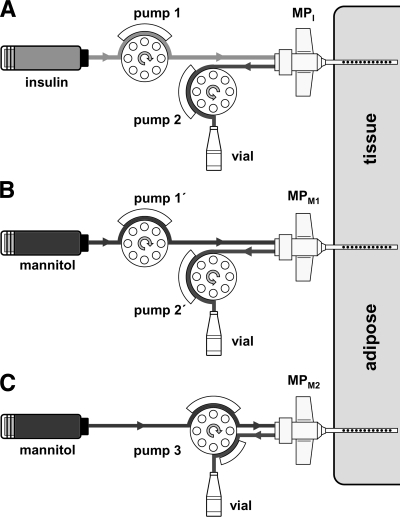Figure 1.
Schematic of the experimental setup for assessing the feasibility of estimating plasma glucose concentrations from the ISF glucose levels observed at the insulin delivery site. A–C: Three MP catheters were inserted into subcutaneous adipose tissue of diabetic subjects (n = 10). One catheter (MPI) was used for glucose sampling and simultaneous insulin delivery (A), and, as controls, two catheters (MPM1 and MPM2) were used for glucose sampling only (B and C). The catheter for glucose sampling and insulin delivery was perfused with a rapid-acting insulin solution (100 units/ml, Aspart) using two peristaltic pumps (A), with one attached to the inflow tubing and one to the outflow tubing (dual-pump operation mode). Insulin delivery rate was adjusted by adjusting the difference between the inflow and outflow rate of the catheter. The outflow conveying the extracted tissue glucose was collected in vials. The efficiency by which glucose was extracted via diffusion from the ISF of the tissue into the catheter (glucose recovery) was measured by applying the ionic reference technique (4,5). The catheters used for glucose sampling only (MPM1 and MPM2) were perfused with an insulin-free solution (5% mannitol) using either a single-pump operation mode where the inflow equaled the outflow rate (C) or a dual-pump operation mode (B) where the inflow and outflow rates equaled those applied in the insulin-perfused MP catheter (A).

